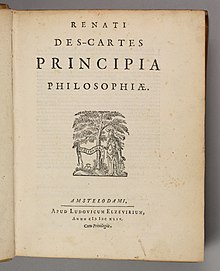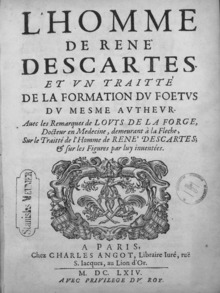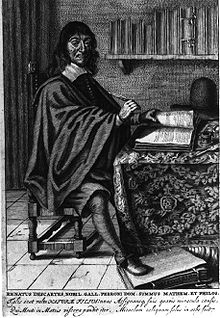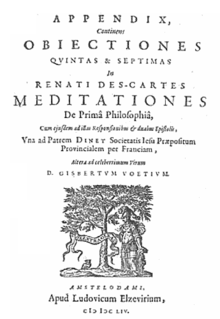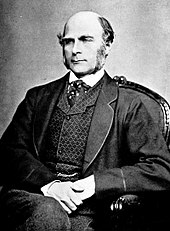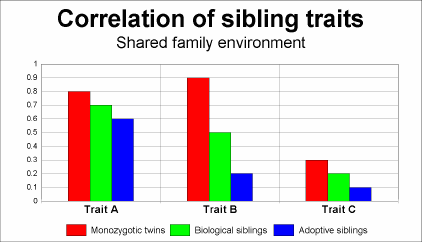René Descartes
| |
|---|---|

Portrait after Frans Hals, 1648
| |
| Born | 31 March 1596 |
| Died | 11 February 1650 (aged 53) |
| Nationality | French |
| Education | Collège Royal Henry-Le-Grand (1607–1614) University of Poitiers (LL.B., 1616) University of Franeker Leiden University |
| Era | 17th-century philosophy |
| Region | Western philosophy |
| School | Rationalism Cartesianism Mechanism Innatism Foundationalism Conceptualism Indirect realism Correspondence theory of truth Corpuscularianism Theological voluntarism |
Main interests
| Metaphysics, epistemology, mathematics, physics, cosmology |
Notable ideas
| Cogito ergo sum Method of doubt Subjectivity Method of normals Analytic geometry Cartesian coordinate system Mind–body problem Cartesian dualism (interactionism) Foundationalism Mathesis universalis Folium of Descartes Dream argument Evil demon Conservation of momentum (quantitas motus) Balloonist theory Wax argument Trademark argument Causal adequacy principle Res cogitans/res extensa distinction Conatus |
| Signature | |
René Descartes (/deɪˈkɑːrt/, UK also /ˈdeɪkɑːrt/; French: [ʁəne dekaʁt]; Latinized: Renatus Cartesius; adjectival form: "Cartesian"; 31 March 1596 – 11 February 1650) was a French philosopher, mathematician, and scientist. A native of the Kingdom of France, he spent about 20 years (1629–49) of his life in the Dutch Republic after serving for a while in the Dutch States Army of Maurice of Nassau, Prince of Orange and the Stadtholder of the United Provinces. He is generally considered one of the most notable intellectual figures of the Dutch Golden Age.
Descartes' Meditations on First Philosophy (1641) continues to be a standard text at most university philosophy departments. Descartes' influence in mathematics is equally apparent; the Cartesian coordinate system was named after him. He is credited as the father of analytical geometry, the bridge between algebra and geometry, used in the discovery of infinitesimal calculus and analysis. Descartes was also one of the key figures in the Scientific Revolution.
Descartes refused to accept the authority of previous philosophers. He frequently set his views apart from those of his predecessors. In the opening section of the Passions of the Soul, an early modern treatise on emotions, Descartes goes so far as to assert that he will write on this topic "as if no one had written on these matters before". His best known philosophical statement is "I think, therefore I am" (French: Je pense, donc je suis; Latin: Ego cogito, ergo sum), found in Discourse on the Method (1637; written in French and Latin) and Principles of Philosophy (1644; written in Latin).
Many elements of his philosophy have precedents in late Aristotelianism, the revived Stoicism of the 16th century, or in earlier philosophers like Augustine. In his natural philosophy, he differed from the schools on two major points: first, he rejected the splitting of corporeal substance into matter and form; second, he rejected any appeal to final ends, divine or natural, in explaining natural phenomena. In his theology, he insists on the absolute freedom of God's act of creation.
Descartes laid the foundation for 17th-century continental rationalism, later advocated by Spinoza and Leibniz, and opposed by the empiricist school of thought consisting of Hobbes, Locke, Berkeley, and Hume. Leibniz, Spinoza, and Descartes were all well-versed in mathematics as well as philosophy, and Descartes and Leibniz contributed greatly to science as well.
Life
Early life
The house where Descartes was born in La Haye en Touraine
Graduation registry for Descartes at the University of Poitiers, 1616
René Descartes was born in La Haye en Touraine (now Descartes, Indre-et-Loire),
France, on 31 March 1596. His mother, Jeanne Brochard, died soon after
giving birth to him, and so he was not expected to survive. Descartes'
father, Joachim, was a member of the Parlement of Brittany at Rennes.
René lived with his grandmother and with his great-uncle. Although the
Descartes family was Roman Catholic, the Poitou region was controlled by
the Protestant Huguenots. In 1607, late because of his fragile health, he entered the Jesuit Collège Royal Henry-Le-Grand at La Flèche,
where he was introduced to mathematics and physics, including Galileo's
work. After graduation in 1614, he studied for two years (1615–16) at
the University of Poitiers, earning a Baccalauréat and Licence in canon and civil law in 1616, in accordance with his father's wishes that he should become a lawyer. From there he moved to Paris.
In Discourse on the Method, Descartes recalls,
I entirely abandoned the study of letters. Resolving to seek no knowledge other than that of which could be found in myself or else in the great book of the world, I spent the rest of my youth traveling, visiting courts and armies, mixing with people of diverse temperaments and ranks, gathering various experiences, testing myself in the situations which fortune offered me, and at all times reflecting upon whatever came my way so as to derive some profit from it.
Given his ambition to become a professional military officer, in 1618, Descartes joined, as a mercenary, the Protestant Dutch States Army in Breda under the command of Maurice of Nassau, and undertook a formal study of military engineering, as established by Simon Stevin.
Descartes, therefore, received much encouragement in Breda to advance
his knowledge of mathematics. In this way, he became acquainted with Isaac Beeckman, the principal of a Dordrecht school, for whom he wrote the Compendium of Music (written 1618, published 1650). Together they worked on free fall, catenary, conic section, and fluid statics. Both believed that it was necessary to create a method that thoroughly linked mathematics and physics.
While in the service of the Catholic Duke Maximilian of Bavaria since 1619, Descartes was present at the Battle of the White Mountain outside Prague, in November 1620.
Visions
According to Adrien Baillet, on the night of 10–11 November 1619 (St. Martin's Day), while stationed in Neuburg an der Donau, Descartes shut himself in a room with an "oven" (probably a Kachelofen or masonry heater) to escape the cold. While within, he had three dreams
and believed that a divine spirit revealed to him a new philosophy.
However, it is likely that what Descartes considered to be his second
dream was actually an episode of exploding head syndrome. Upon exiting, he had formulated analytical geometry
and the idea of applying the mathematical method to philosophy. He
concluded from these visions that the pursuit of science would prove to
be, for him, the pursuit of true wisdom and a central part of his life's
work.
Descartes also saw very clearly that all truths were linked with one
another so that finding a fundamental truth and proceeding with logic
would open the way to all science. Descartes discovered this basic truth
quite soon: his famous "I think, therefore I am".
France
In 1620 Descartes left the army. He visited Basilica della Santa Casa
in Loreto, then visited various countries before returning to France,
and during the next few years spent time in Paris. It was there that he
composed his first essay on method: Regulae ad Directionem Ingenii (Rules for the Direction of the Mind). He arrived in La Haye in 1623, selling all of his property to invest in bonds, which provided a comfortable income for the rest of his life. Descartes was present at the siege of La Rochelle by Cardinal Richelieu in 1627. In the fall of the same year, in the residence of the papal nuncio Guidi di Bagno, where he came with Mersenne
and many other scholars to listen to a lecture given by the alchemist
Nicolas de Villiers, Sieur de Chandoux on the principles of a supposed
new philosophy, Cardinal Bérulle urged him to write an exposition of his own new philosophy in some location beyond the reach of the inquisition.
Netherlands
In Amsterdam, Descartes lived on Westermarkt 6 (Descarteshuis, on the left).
Descartes returned to the Dutch Republic in 1628. In April 1629 he joined the University of Franeker, studying under Adriaan Metius, living either with a Catholic family, or renting the Sjaerdemaslot, where he invited in vain a French cook and an optician. The next year, under the name "Poitevin", he enrolled at the Leiden University to study mathematics with Jacobus Golius, who confronted him with Pappus's hexagon theorem, and astronomy with Martin Hortensius.
In October 1630 he had a falling-out with Beeckman, whom he accused of
plagiarizing some of his ideas. In Amsterdam, he had a relationship with
a servant girl, Helena Jans van der Strom, with whom he had a daughter,
Francine, who was born in 1635 in Deventer. She died of scarlet fever at the age of 5.
Unlike many moralists of the time, Descartes was not devoid of
passions but rather defended them; he wept upon Francine's death in
1640. "Descartes said that he did not believe that one must refrain from tears to prove oneself a man." Russell Shorto
postulated that the experience of fatherhood and losing a child formed a
turning point in Descartes' work, changing its focus from medicine to a
quest for universal answers.
Despite frequent moves,
he wrote all his major work during his 20-plus years in the
Netherlands, where he managed to revolutionize mathematics and
philosophy. In 1633, Galileo was condemned by the Italian Inquisition, and Descartes abandoned plans to publish Treatise on the World,
his work of the previous four years. Nevertheless, in 1637 he published
part of this work in three essays: "Les Météores" (The Meteors), "La Dioptrique" (Dioptrics) and "La Géométrie" (Geometry), preceded by an introduction, his famous Discours de la méthode
(Discourse on the Method). In it, Descartes lays out four rules of
thought, meant to ensure that our knowledge rests upon a firm
foundation.
The first was never to accept anything for true which I did not clearly know to be such; that is to say, carefully to avoid precipitancy and prejudice, and to comprise nothing more in my judgment than what was presented to my mind so clearly and distinctly as to exclude all ground of doubt.
In La Géométrie, Descartes exploited the discoveries he made with Pierre de Fermat,
having been able to do so because his paper, Introduction to Loci, was
published posthumously in 1679. This later became known as Cartesian
Geometry.
Principia philosophiae, 1644
Descartes continued to publish works concerning both mathematics and
philosophy for the rest of his life. In 1641 he published a metaphysics
work, Meditationes de Prima Philosophia (Meditations on First Philosophy), written in Latin and thus addressed to the learned. It was followed, in 1644, by Principia Philosophiæ (Principles of Philosophy), a kind of synthesis of the Discourse on the Method and Meditations on First Philosophy.
In 1643, Cartesian philosophy was condemned at the University of
Utrecht, and Descartes was obliged to flee to the Hague, and settled in Egmond-Binnen.
Descartes began (through Alfonso Polloti, an Italian general in Dutch service) a long correspondence with Princess Elisabeth of Bohemia, devoted mainly to moral and psychological subjects. Connected with this correspondence, in 1649 he published Les Passions de l'âme (Passions of the Soul), that he dedicated to the Princess. In 1647, he was awarded a pension by King Louis XIV of France, though it was never paid. A French translation of Principia Philosophiæ, prepared by Abbot Claude Picot, was published in 1647. This edition Descartes also dedicated to Princess Elisabeth. In the preface to the French edition,
Descartes praised true philosophy as a means to attain wisdom. He
identifies four ordinary sources to reach wisdom and finally says that
there is a fifth, better and more secure, consisting in the search for
first causes.
Sweden
René Descartes (right) with Queen Christina of Sweden (left)
The rear of the "von der Lindeska huset" on Västerlånggatan 68
By
1649, Descartes had become famous throughout Europe for being one of
the continent's greatest philosophers and scientists. That year, Queen Christina of Sweden
invited Descartes to her court to organize a new scientific academy and
tutor her in his ideas about love. She was interested in and stimulated
Descartes to publish the "Passions of the Soul", a work based on his correspondence with Princess Elisabeth. Descartes accepted, and moved to Sweden in the middle of winter.
He was a guest at the house of Pierre Chanut, living on Västerlånggatan, less than 500 meters from Tre Kronor in Stockholm. There, Chanut and Descartes made observations with a Torricellian barometer, a tube with mercury. Challenging Blaise Pascal, Descartes took the first set of barometric readings in Stockholm to see if atmospheric pressure could be used in forecasting the weather.
Death
The tomb of Descartes (middle, with detail of the inscription), in the Abbey of Saint-Germain-des-Prés, Paris
His memorial, erected in the 1720s, in the Adolf Fredriks kyrka
Descartes apparently started giving lessons to Queen Christina after
her birthday, three times a week, at 5 a.m, in her cold and draughty
castle. Soon it became clear they did not like each other; she did not
like his mechanical philosophy, nor did he appreciate her interest in Ancient Greek. By 15 January 1650, Descartes had seen Christina only four or five times. On 1 February he contracted pneumonia and died on 11 February. The cause of death was pneumonia according to Chanut, but peripneumonia according to the doctor Van Wullen who was not allowed to bleed him. (The winter seems to have been mild,
except for the second half of January which was harsh as described by
Descartes himself; however, "this remark was probably intended to be as
much Descartes' take on the intellectual climate as it was about the
weather.")
In 1996 E. Pies, a German scholar, published a book questioning
this account, based on a letter by Johann van Wullen, who had been sent
by Christina to treat him, something Descartes refused, and more
arguments against its veracity have been raised since. Descartes might have been assassinated as he asked for an emetic: wine mixed with tobacco.
As a Catholic in a Protestant nation, he was interred in a graveyard used mainly for orphans in Adolf Fredriks kyrka in Stockholm. His manuscripts came into the possession of Claude Clerselier,
Chanut's brother-in-law, and "a devout Catholic who has begun the
process of turning Descartes into a saint by cutting, adding and
publishing his letters selectively." In 1663, the Pope placed his works on the Index of Prohibited Books. In 1666 his remains were taken to France and buried in the Saint-Étienne-du-Mont. In 1671 Louis XIV prohibited all the lectures in Cartesianism. Although the National Convention in 1792 had planned to transfer his remains to the Panthéon, he was reburied in the Abbey of Saint-Germain-des-Prés in 1819, missing a finger and the skull. His skull is on display in the Musée de l'Homme in Paris.
Philosophical work
Initially, Descartes arrives at only a single first principle: I
think. Thought cannot be separated from me, therefore, I exist (Discourse on the Method and Principles of Philosophy). Most famously, this is known as cogito ergo sum
(English: "I think, therefore I am"). Therefore, Descartes concluded,
if he doubted, then something or someone must be doing the doubting,
therefore the very fact that he doubted proved his existence. "The
simple meaning of the phrase is that if one is skeptical of existence,
that is in and of itself proof that he does exist."
These two first principles—I think and I exist—were later confirmed by
Descartes's clear and distinct perception (delineated in his Third
Meditation): that I clearly and distinctly perceive these two
principles, Descartes reasoned, ensures their indubitability.
Descartes concludes that he can be certain that he exists because
he thinks. But in what form? He perceives his body through the use of
the senses; however, these have previously been unreliable. So Descartes
determines that the only indubitable knowledge is that he is a thinking thing. Thinking is what he does, and his power must come from his essence. Descartes defines "thought" (cogitatio)
as "what happens in me such that I am immediately conscious of it,
insofar as I am conscious of it". Thinking is thus every activity of a
person of which the person is immediately conscious. He gave reasons for thinking that waking thoughts are distinguishable from dreams, and that one's mind cannot have been "hijacked" by an evil demon placing an illusory external world before one's senses.
And so something that I thought I was seeing with my eyes is in fact grasped solely by the faculty of judgment which is in my mind.
In this manner, Descartes proceeds to construct a system of knowledge, discarding perception as unreliable and, instead, admitting only deduction as a method.
Dualism
L'homme (1664)
Descartes, influenced by the automatons on display throughout the city of Paris, began to investigate the connection between the mind and body, and how the two interact. His main influences for dualism were theology and physics. The theory on the dualism of mind and body is Descartes' signature doctrine and permeates other theories he advanced. Known as Cartesian dualism (or Mind-Body Dualism), his theory on the separation between the mind and the body went on to influence subsequent Western philosophies. In Meditations on First Philosophy, Descartes attempted to demonstrate the existence of God and the distinction between the human soul and the body. Humans are a union of mind and body; thus Descartes' dualism embraced the idea that mind and body are distinct but closely joined. While many contemporary readers of Descartes found the distinction between mind and body difficult to grasp, he thought it was entirely straightforward. Descartes employed the concept of modes, which are the ways in which substances exist. In Principles of Philosophy, Descartes explained, "we can clearly perceive a substance apart from the mode which we say differs from it, whereas we cannot, conversely, understand the mode apart from the substance". To perceive a mode apart from its substance requires an intellectual abstraction, which Descartes explained as follows:
The intellectual abstraction consists in my turning my thought away from one part of the contents of this richer idea the better to apply it to the other part with greater attention. Thus, when I consider a shape without thinking of the substance or the extension whose shape it is, I make a mental abstraction.
According to Descartes two substances are really distinct when each
of them can exist apart from the other. Thus Descartes reasoned that God
is distinct from humans, and the body and mind of a human are also
distinct from one another.
He argued that the great differences between body (an extended thing)
and mind (an un-extended, immaterial thing) make the two ontologically
distinct. But that the mind was utterly indivisible: because "when I
consider the mind, or myself in so far as I am merely a thinking thing, I
am unable to distinguish any part within myself; I understand myself to
be something quite single and complete."
In Meditations Descartes discussed a piece of wax
and exposed the single most characteristic doctrine of Cartesian
dualism: that the universe contained two radically different kinds of
substances—the mind or soul defined as thinking, and the body defined as matter and unthinking. The Aristotelian philosophy
of Descartes' days held that the universe was inherently purposeful or
theological. Everything that happened, be it the motion of the stars or the growth of a tree,
was supposedly explainable by a certain purpose, goal or end that
worked its way out within nature. Aristotle called this the "final
cause", and these final causes were indispensable for explaining the
ways nature operated. With his theory on dualism Descartes fired the
opening shot for the battle between the traditional Aristotelian science
and the new science of Kepler and Galileo
which denied the final cause for explaining nature. Descartes' dualism
provided the philosophical rationale for the latter and he expelled the
final cause from the physical universe (or res extensa). For Descartes the only place left for the final cause was the mind (or res cogitans). Therefore, while Cartesian dualism paved the way for modern physics, it also held the door open for religious beliefs about the immortality of the soul.
Descartes' dualism of mind and matter implied a concept of human
beings. A human was according to Descartes a composite entity of mind
and body. Descartes gave priority to the mind and argued that the mind
could exist without the body, but the body could not exist without the
mind. In Meditations Descartes even argues that while the mind is a substance, the body is composed only of "accidents". But he did argue that mind and body are closely joined:
Nature also teaches me, by the sensations of pain, hunger, thirst and so on, that I am not merely present in my body as a pilot in his ship, but that I am very closely joined and, as it were, intermingled with it, so that I and the body form a unit. If this were not so, I, who am nothing but a thinking thing, would not feel pain when the body was hurt, but would perceive the damage purely by the intellect, just as a sailor perceives by sight if anything in his ship is broken.
Descartes' discussion on embodiment raised one of the most perplexing
problems of his dualism philosophy: What exactly is the relationship of
union between the mind and the body of a person? Therefore, Cartesian dualism set the agenda for philosophical discussion of the mind–body problem for many years after Descartes' death. Descartes was also a rationalist and believed in the power of innate ideas. Descartes argued the theory of innate knowledge
and that all humans were born with knowledge through the higher power
of God. It was this theory of innate knowledge that later led
philosopher John Locke (1632–1704) to combat the theory of empiricism, which held that all knowledge is acquired through experience.
Descartes on physiology and psychology
In The Passions of the Soul
written between 1645 and 1646 Descartes discussed the common
contemporary belief that the human body contained animal spirits. These
animal spirits were believed to be light and roaming fluids circulating
rapidly around the nervous system between the brain and the muscles, and
served as a metaphor for feelings, like being in high or bad spirit.
These animal spirits were believed to affect the human soul, or passions
of the soul. Descartes distinguished six basic passions: wonder, love,
hatred, desire, joy and sadness. All of these passions, he argued,
represented different combinations of the original spirit, and
influenced the soul to will or want certain actions. He argued, for
example, that fear is a passion that moves the soul to generate a
response in the body. In line with his dualist teachings on the
separation between the soul and the body, he hypothesized that some part
of the brain served as a connector between the soul and the body and
singled out the pineal gland as connector.
Descartes argued that signals passed from the ear and the eye to the
pineal gland, through animal spirits. Thus different motions in the
gland cause various animal spirits. He argued that these motions in the
pineal gland are based on God's will and that humans are supposed to
want and like things that are useful to them. But he also argued that
the animal spirits that moved around the body could distort the commands
from the pineal gland, thus humans had to learn how to control their
passions.
Descartes advanced a theory on automatic bodily reactions to external events which influenced 19th-century reflex
theory. He argued that external motions such as touch and sound reach
the endings of the nerves and affect the animal spirits. Heat from fire
affects a spot on the skin and sets in motion a chain of reactions, with
the animal spirits reaching the brain through the central nervous
system, and in turn animal spirits are sent back to the muscles to move
the hand away from the fire. Through this chain of reactions the automatic reactions of the body do not require a thought process.
Above all he was among the first scientists who believed that the
soul should be subject to scientific investigation. He challenged the
views of his contemporaries that the soul was divine, thus religious authorities regarded his books as dangerous. Descartes' writings went on to form the basis for theories on emotions and how cognitive
evaluations were translated into affective processes. Descartes
believed that the brain resembled a working machine and unlike many of
his contemporaries believed that mathematics and mechanics could explain
the most complicated processes of the mind. In the 20th century Alan Turing advanced computer science based on mathematical biology as inspired by Descartes. His theories on reflexes also served as the foundation for advanced physiological theories more than 200 years after his death. The physiologist Ivan Pavlov was a great admirer of Descartes.
Descartes' moral philosophy
For Descartes, ethics was a science, the highest and most perfect of them. Like the rest of the sciences, ethics had its roots in metaphysics.
In this way, he argues for the existence of God, investigates the place
of man in nature, formulates the theory of mind-body dualism, and
defends free will.
However, as he was a convinced rationalist, Descartes clearly states
that reason is sufficient in the search for the goods that we should
seek, and virtue
consists in the correct reasoning that should guide our actions.
Nevertheless, the quality of this reasoning depends on knowledge,
because a well-informed mind will be more capable of making good choices,
and it also depends on mental condition. For this reason, he said that a
complete moral philosophy should include the study of the body. He
discussed this subject in the correspondence with Princess Elisabeth of Bohemia, and as a result wrote his work The Passions of the Soul, that contains a study of the psychosomatic processes and reactions in man, with an emphasis on emotions or passions. His works about human passion and emotion would be the basis for the philosophy of his followers (see Cartesianism),
and would have a lasting impact on ideas concerning what literature and
art should be, specifically how it should invoke emotion.
Humans should seek the sovereign good that Descartes, following Zeno, identifies with virtue, as this produces a solid blessedness or pleasure. For Epicurus
the sovereign good was pleasure, and Descartes says that, in fact, this
is not in contradiction with Zeno's teaching, because virtue produces a
spiritual pleasure, that is better than bodily pleasure. Regarding Aristotle's
opinion that happiness depends on the goods of fortune, Descartes does
not deny that this good contributes to happiness but remarks that they
are in great proportion outside one's own control, whereas one's mind is
under one's complete control. The moral writings of Descartes came at the last part of his life, but earlier, in his Discourse on the Method he adopted three maxims to be able to act while he put all his ideas into doubt. This is known as his "Provisional Morals".
Descartes on religious beliefs
René Descartes at work
In the third and fifth Meditation, he offers an ontological proof of a benevolent God (through both the ontological argument and trademark argument). Because God is benevolent, he can have some faith in the account of reality his senses provide him, for God has provided him with a working mind and sensory system and does not desire to deceive him. From this supposition, however, he finally establishes the possibility of acquiring knowledge about the world based on deduction and perception. Regarding epistemology, therefore, he can be said to have contributed such ideas as a rigorous conception of foundationalism and the possibility that reason is the only reliable method of attaining knowledge. He, nevertheless, was very much aware that experimentation was necessary to verify and validate theories.
In his Meditations on First Philosophy Descartes sets
forth two proofs for God's existence. One of these is founded upon the
possibility of thinking the "idea of a being that is supremely perfect
and infinite," and suggests that "of all the ideas that are in me, the
idea that I have of God is the most true, the most clear and distinct." Descartes considered himself to be a devout Catholic and one of the purposes of the Meditations
was to defend the Catholic faith. His attempt to ground theological
beliefs on reason encountered intense opposition in his time, however: Pascal regarded Descartes' views as rationalist and mechanist, and accused him of deism:
"I cannot forgive Descartes; in all his philosophy, Descartes did his
best to dispense with God. But Descartes could not avoid prodding God to
set the world in motion with a snap of his lordly fingers; after that,
he had no more use for God," while a powerful contemporary, Martin Schoock, accused him of atheist beliefs, though Descartes had provided an explicit critique of atheism in his Meditations. The Catholic Church prohibited his books in 1663.
Descartes also wrote a response to external world skepticism.
Through this method of skepticism, he does not doubt for the sake of
doubting but to achieve concrete and reliable information. In other
words, certainty. He argues that sensory perceptions
come to him involuntarily, and are not willed by him. They are external
to his senses, and according to Descartes, this is evidence of the
existence of something outside of his mind, and thus, an external world.
Descartes goes on to show that the things in the external world are
material by arguing that God would not deceive him as to the ideas that
are being transmitted, and that God has given him the "propensity" to
believe that such ideas are caused by material things. Descartes also
believes a substance is something that does not need any assistance to
function or exist. Descartes further explains how only God can be a true
“substance”. But minds are substances, meaning they need only God for
it to function. The mind is a thinking substance. The means for a
thinking substance stem from ideas.
Descartes and natural science
Descartes is often regarded as the first thinker to emphasize the use of reason to develop the natural sciences. For him the philosophy was a thinking system that embodied all knowledge, and expressed it in this way:
Thus, all Philosophy is like a tree, of which Metaphysics is the root, Physics the trunk, and all the other sciences the branches that grow out of this trunk, which are reduced to three principals, namely, Medicine, Mechanics, and Ethics. By the science of Morals, I understand the highest and most perfect which, presupposing an entire knowledge of the other sciences, is the last degree of wisdom.
In his Discourse on the Method, he attempts to arrive at a
fundamental set of principles that one can know as true without any
doubt. To achieve this, he employs a method called
hyperbolical/metaphysical doubt, also sometimes referred to as methodological skepticism:
he rejects any ideas that can be doubted and then re-establishes them
in order to acquire a firm foundation for genuine knowledge.
Descartes built his ideas from scratch. He relates this to
architecture: the top soil is taken away to create a new building or
structure. Descartes calls his doubt the soil and new knowledge the
buildings. To Descartes, Aristotle's foundationalism is incomplete and
his method of doubt enhances foundationalism.
Descartes on animals
Descartes
denied that animals had reason or intelligence. He argued that animals
did not lack sensations or perceptions, but these could be explained
mechanistically. Whereas humans had a soul, or mind, and were able to feel pain and anxiety,
animals by virtue of not having a soul could not feel pain or anxiety.
If animals showed signs of distress then this was to protect the body
from damage, but the innate state needed for them to suffer
was absent. Although Descartes' views were not universally accepted
they became prominent in Europe and North America, allowing humans to
treat animals with impunity. The view that animals were quite separate
from humanity and merely machines
allowed for the maltreatment of animals, and was sanctioned in law and
societal norms until the middle of the 19th century. The publications of
Charles Darwin
would eventually erode the Cartesian view of animals. Darwin argued
that the continuity between humans and other species opened the
possibilities that animals did not have dissimilar properties to suffer.
Historical impact
Emancipation from Church doctrine
Cover of Meditations
Descartes has often been dubbed the father of modern Western philosophy, the thinker whose approach has profoundly changed the course of Western philosophy and set the basis for modernity. The first two of his Meditations on First Philosophy, those that formulate the famous methodic doubt, represent the portion of Descartes' writings that most influenced modern thinking. It has been argued that Descartes himself didn't realize the extent of this revolutionary move.
In shifting the debate from "what is true" to "of what can I be
certain?," Descartes arguably shifted the authoritative guarantor of
truth from God to humanity (even though Descartes himself claimed he
received his visions from God)—while the traditional concept of "truth"
implies an external authority, "certainty" instead relies on the
judgment of the individual.
In an anthropocentric revolution, the human being is now raised to the level of a subject, an agent, an emancipated
being equipped with autonomous reason. This was a revolutionary step
that established the basis of modernity, the repercussions of which are
still being felt: the emancipation of humanity from Christian revelational truth and Church doctrine; humanity making its own law and taking its own stand.
In modernity, the guarantor of truth is not God anymore but human
beings, each of whom is a "self-conscious shaper and guarantor" of their
own reality. In that way, each person is turned into a reasoning adult, a subject and agent,
as opposed to a child obedient to God. This change in perspective was
characteristic of the shift from the Christian medieval period to the
modern period, a shift that had been anticipated in other fields, and
which was now being formulated in the field of philosophy by Descartes.
This anthropocentric perspective of Descartes' work, establishing human reason as autonomous, provided the basis for the Enlightenment's
emancipation from God and the Church. According to Martin Heidegger,
the perspective of Descartes' work also provided the basis for all
subsequent anthropology. Descartes' philosophical revolution is sometimes said to have sparked modern anthropocentrism and subjectivism.
Mathematical legacy
A Cartesian coordinates graph, using his invented x and y axes
One of Descartes' most enduring legacies was his development of Cartesian or analytic geometry, which uses algebra to describe geometry. He "invented the convention of representing unknowns in equations by x, y, and z, and knowns by a, b, and c". He also "pioneered the standard notation" that uses superscripts to show the powers or exponents; for example, the 2 used in x2 to indicate x squared.
He was first to assign a fundamental place for algebra in our system of
knowledge, using it as a method to automate or mechanize reasoning,
particularly about abstract, unknown quantities. European mathematicians
had previously viewed geometry as a more fundamental form of
mathematics, serving as the foundation of algebra. Algebraic rules were
given geometric proofs by mathematicians such as Pacioli, Cardan, Tartaglia and Ferrari. Equations of degree
higher than the third were regarded as unreal, because a
three-dimensional form, such as a cube, occupied the largest dimension
of reality. Descartes professed that the abstract quantity a2 could represent length as well as an area. This was in opposition to the teachings of mathematicians, such as Vieta, who argued that it could represent only area. Although Descartes did not pursue the subject, he preceded Gottfried Wilhelm Leibniz in envisioning a more general science of algebra or "universal mathematics," as a precursor to symbolic logic, that could encompass logical principles and methods symbolically, and mechanize general reasoning.
Descartes' work provided the basis for the calculus developed by Newton and Leibniz, who applied infinitesimal calculus to the tangent line problem, thus permitting the evolution of that branch of modern mathematics. His rule of signs is also a commonly used method to determine the number of positive and negative roots of a polynomial.
The beginning to Descartes' interest in physics is accredited to the amateur scientist and mathematician Isaac Beeckman, who was at the forefront of a new school of thought known as mechanical philosophy. With this foundation of reasoning, Descartes formulated many of his theories on mechanical and geometrical physics. Descartes discovered an early form of the law of conservation of mechanical momentum
(a measure of the motion of an object), and envisioned it as pertaining
to motion in a straight line, as opposed to perfect circular motion, as
Galileo had envisioned it. He outlined his views on the universe in his Principles of Philosophy.
Descartes also made contributions to the field of optics. He showed by using geometric construction and the law of refraction (also known as Descartes' law or more commonly Snell's law) that the angular radius of a rainbow
is 42 degrees (i.e., the angle subtended at the eye by the edge of the
rainbow and the ray passing from the sun through the rainbow's center is
42°). He also independently discovered the law of reflection, and his essay on optics was the first published mention of this law.
Influence on Newton's mathematics
Current
opinion is that Descartes had the most influence of anyone on the young
Newton, and this is arguably one of Descartes' most important
contributions. Newton continued Descartes' work on cubic equations,
which will free the subject from fetters of the Greek perspectives. The
most important concept was his very modern treatment of single
variables.
Contemporary reception
Although
Descartes was well known in academic circles towards the end of his
life, the teaching of his works in schools was controversial. Henri de
Roy (Henricus Regius, 1598–1679), Professor of Medicine at the University of Utrecht, was condemned by the Rector of the University, Gijsbert Voet (Voetius), for teaching Descartes' physics.
Legacy
- Mathematical concepts named after Descartes
- Cartesian circle
- Cartesian coordinate system
- Cartesian diagram
- Cartesian diver
- Cartesian morphism
- Cartesian plane
- Cartesian product
- Cartesian product of graphs
- Cartesian theater
- Cartesian tree
- Descartes' rule of signs
- Descartes' theorem (4 tangent circles)
- Descartes' theorem on total angular defect
- Folium of Descartes
- Other
- Cartesian doubt
- 3587 Descartes, asteroid
- Cartesian materialism (not a view that was held by or formulated by Descartes)
- Paris Descartes University
Writings
Handwritten letter by Descartes, December 1638
Principia philosophiae (1685)
- 1618. Musicae Compendium. A treatise on music theory and the aesthetics of music written for Descartes' early collaborator, Isaac Beeckman (first posthumous edition 1650).
- 1626–1628. Regulae ad directionem ingenii (Rules for the Direction of the Mind). Incomplete. First published posthumously in Dutch translation in 1684 and in the original Latin at Amsterdam in 1701 (R. Des-Cartes Opuscula Posthuma Physica et Mathematica). The best critical edition, which includes the Dutch translation of 1684, is edited by Giovanni Crapulli (The Hague: Martinus Nijhoff, 1966).
- 1630–1631. La recherche de la vérité par la lumière naturelle (The Search for Truth) unfinished dialogue published in 1701.
- 1630–1633. Le Monde (The World) and L'Homme (Man). Descartes' first systematic presentation of his natural philosophy. Man was published posthumously in Latin translation in 1662; and The World posthumously in 1664.
- 1637. Discours de la méthode (Discourse on the Method). An introduction to the Essais, which include the Dioptrique, the Météores and the Géométrie.
- 1637. La Géométrie (Geometry). Descartes' major work in mathematics. There is an English translation by Michael Mahoney (New York: Dover, 1979).
- 1641. Meditationes de prima philosophia (Meditations on First Philosophy), also known as Metaphysical Meditations. In Latin; a second edition, published the following year, included an additional objection and reply, and a Letter to Dinet. A French translation by the Duke of Luynes, probably done without Descartes' supervision, was published in 1647. Includes six Objections and Replies.
- 1644. Principia philosophiae (Principles of Philosophy), a Latin textbook at first intended by Descartes to replace the Aristotelian textbooks then used in universities. A French translation, Principes de philosophie by Claude Picot, under the supervision of Descartes, appeared in 1647 with a letter-preface to Princess Elisabeth of Bohemia.
- 1647. Notae in programma (Comments on a Certain Broadsheet). A reply to Descartes' one-time disciple Henricus Regius.
- 1648. La description du corps humain (The Description of the Human Body). Published posthumously by Clerselier in 1667.
- 1648. Responsiones Renati Des Cartes... (Conversation with Burman). Notes on a Q&A session between Descartes and Frans Burman on 16 April 1648. Rediscovered in 1895 and published for the first time in 1896. An annotated bilingual edition (Latin with French translation), edited by Jean-Marie Beyssade, was published in 1981 (Paris: PUF).
- 1649. Les passions de l'âme (Passions of the Soul). Dedicated to Princess Elisabeth of the Palatinate.
- 1657. Correspondance (three volumes: 1657, 1659, 1667). Published by Descartes' literary executor Claude Clerselier. The third edition, in 1667, was the most complete; Clerselier omitted, however, much of the material pertaining to mathematics.
In January 2010, a previously unknown letter from Descartes, dated 27
May 1641, was found by the Dutch philosopher Erik-Jan Bos when browsing
through Google. Bos found the letter mentioned in a summary of autographs kept by Haverford College in Haverford, Pennsylvania.
The college was unaware that the letter had never been published. This
was the third letter by Descartes found in the last 25 years.



